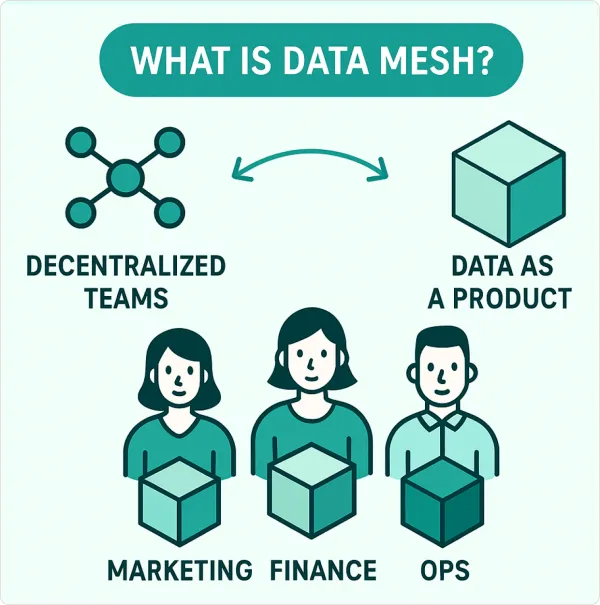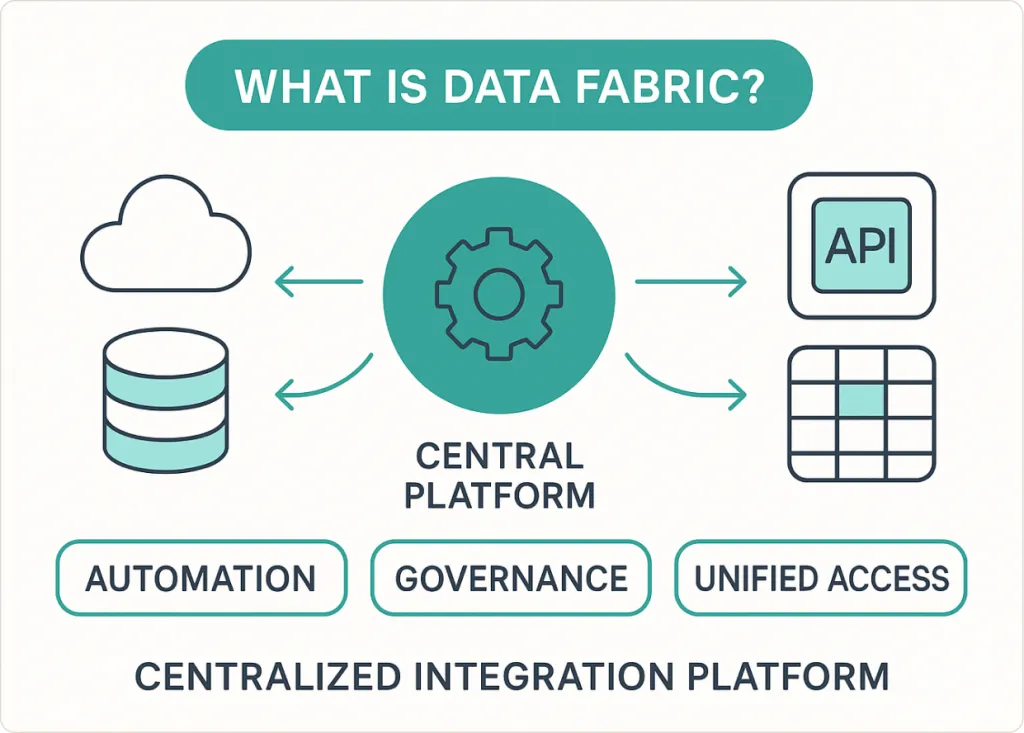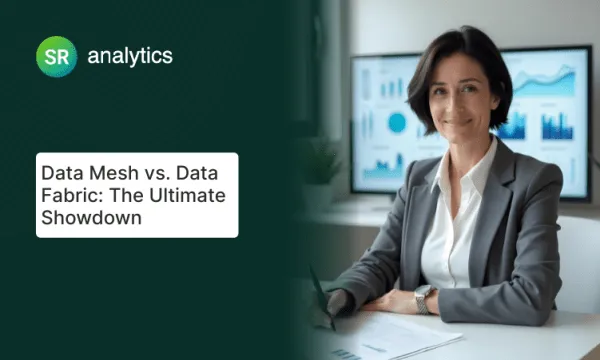Key Highlights:
- Data mesh decentralizes ownership to domain teams, while data fabric centralizes integration through unified layers
- Success depends on organizational structure, compliance needs, cultural readiness, and technical capabilities
- 80% of enterprises are expected to adopt hybrid mesh-fabric combinations by 2028
- Data mesh suits autonomous cultures; data fabric fits centralized governance and real-time integration needs
- Your choice impacts marketing campaign speed and executive decision-making velocity organization-wide
- Pilot projects allow testing approaches before full-scale implementation commitment
“Are you building a data architecture that scales with your ambitions, or one that limits your potential?”
Introduction
Imagine your organization drowning in data silos, with each department fighting for analytics resources while critical insights remain buried. Two powerful “data heroes” emerge to save the day: Data Mesh promises federation and domain autonomy, while Data Fabric offers seamless integration and centralized control. But which champion deserves your investment?
The data mesh vs data fabric debate has become the heavyweight title match of modern data architecture. With enterprises generating more data than ever, choosing between data mesh vs data fabric approaches can determine whether your organization achieves data-driven agility or gets trapped in analysis paralysis. The stakes couldn’t be higher – the wrong choice can cost millions in wasted resources and missed opportunities.
What is Data Mesh? (Decentralized Data Architecture)

Data mesh is a decentralized data architecture approach that empowers domain-specific teams to own and manage their data assets, treating data as a product. Rather than centralizing all data operations under a single IT team, this decentralized data architecture enables individual business domains to own, develop, and share their data products independently.
Originally conceptualized by Zhamak Dehghani at ThoughtWorks, data mesh represents a paradigm shift from traditional centralized data platforms to distributed, domain-oriented data ownership.
Key Principles of Data Mesh Architecture
The data mesh architecture framework operates on four fundamental pillars that define this decentralized data architecture:
- Domain-oriented ownership: Each business domain (marketing, sales, finance) owns and manages their specific data assets
- Data as a product: Teams treat their data outputs as products with clear ownership, quality standards, and user experience considerations
- Self-serve data infrastructure: Domain teams access standardized tools and platforms to build and deploy data products independently
- Federated governance: Central standards exist but are implemented and executed by individual domains
Benefits of Data Mesh Architecture
Greater Agility & Scalability: Domain teams using data mesh architecture can innovate and iterate on their data products without waiting for central IT approval, dramatically reducing time-to-insight.
Domain Expertise Utilization: In a decentralized data architecture, data is managed by those who understand it best – marketing teams handle marketing data, sales teams manage customer data, ensuring higher quality and relevance.
No Single Point of Failure: This decentralized data architecture eliminates the bottleneck of overloaded central data teams, allowing multiple domains to work simultaneously.
Challenges of Data Mesh Architecture
Consistency & Governance Difficulties: Without careful coordination, different domains in a decentralized data architecture may develop incompatible data standards, creating new silos.
Requires Cultural Change: Success with data mesh architecture demands that business teams embrace data ownership and develop technical capabilities – a significant organizational shift.
Infrastructure Complexity: Implementing self-serve platforms and ensuring domain teams can manage their own data products in this decentralized data architecture requires sophisticated coordination.
What is Data Fabric? (Centralized Integration Platform)

Data fabric is a unified data management architecture that creates a single accessible layer connecting all data sources, managed centrally through automated integration and governance. Understanding data fabric use cases helps organizations evaluate when this centralized approach delivers maximum value.
Key Components of Data Fabric
Data fabric architectures, across various data fabric use cases, typically include:
- Central data catalog: A comprehensive inventory of all organizational data assets with metadata and lineage
- Metadata-driven automation: AI and machine learning capabilities that automate data discovery, integration, and governance
- Universal connectivity: APIs and connectors that link disparate data sources into one cohesive platform
- Single governance framework: Centralized policies for security, compliance, and data quality
Benefits of Data Fabric
Single Source of Truth: Among key data fabric use cases, providing consistent, high-quality data access across the entire organization eliminates conflicting reports and data confusion.
Faster Insights via Automation: Advanced metadata management and AI-driven integration enable real-time analytics and automated data discovery across data fabric use cases.
Simplified Compliance: Centralized governance makes it easier to enforce security policies and regulatory requirements, especially critical for highly regulated data fabric use cases.
Challenges of Data Fabric
Complex Implementation & Cost: Building a comprehensive data fabric requires significant investment in integrated platforms, skilled data engineers, and ongoing vendor support.
Potential Bottlenecks: Central data teams can become gatekeepers, slowing down domain-specific needs and limiting organizational agility.
Less Flexibility for Domains: Rigid centralized structures may stifle domain-specific innovation if applied too strictly across diverse business needs.
Key Differences: Data Mesh vs Data Fabric
At the highest level, when comparing data mesh vs data fabric, the fundamental distinction is that data mesh focuses on organizational and process changes, while data fabric emphasizes technology and infrastructure solutions. Understanding data mesh vs data fabric differences helps organizations make informed architectural decisions.
Architecture and Philosophy
Data Mesh = A decentralized data architecture where each domain operates independent data pipelines and storage, connected through APIs and shared standards.
Data Fabric = Centralized platform with an overarching integration layer that connects all data sources through a unified backbone.
Think of the data mesh vs data fabric comparison like this: data mesh resembles a network of independent city neighborhoods (decentralized data architecture), each managing their own resources, while data fabric resembles a centralized transportation system connecting everything through main highways.
Data Ownership Model
In the data mesh vs data fabric comparison, ownership models differ significantly:
Data Mesh: Domain teams own and publish data products using a “data as a product” mindset – marketing owns marketing data, sales owns customer data.
Data Fabric: Central data team or IT department manages data as a shared organizational asset within a unified system.
Governance Approach
The data mesh vs data fabric governance models represent opposite philosophies:
Data Mesh: Federated governance where central standards exist but are implemented locally by each domain team in this decentralized data architecture.
Data Fabric: Centralized governance with policies enforced uniformly across the entire platform.
Technology Stack
Understanding the technology implications in data mesh vs data fabric helps organizations plan implementation:
Data Mesh: Typically involves multiple decentralized tools, event streaming platforms, microservices, and polyglot storage solutions requiring API integration in this decentralized data architecture.
Data Fabric: Often utilizes single-vendor or tightly integrated technology stacks, employing data virtualization, master data management, and AI-driven metadata automation.
Scalability Focus
The data mesh vs data fabric scaling approaches differ fundamentally:
Data Mesh: Scales organizationally by adding more domain teams and data products, but risks inconsistencies without proper coordination in this decentralized data architecture.
Data Fabric: Scales data volume and processing centrally but may face bottlenecks or complexity at very large organizational scales.
Comparison Table: Data Mesh vs Data Fabric
| Aspect | Data Mesh (Decentralized Data Architecture) | Data Fabric (Centralized) |
|---|---|---|
| Ownership | Domain teams own & publish data products | Central data team manages unified data assets |
| Architecture | Decentralized data architecture with domain-specific storage | Unified platform/layer connecting all sources |
| Governance | Federated – central standards, local execution | Centralized – global policies enforced uniformly |
| Scaling Focus | Scales organizationally (add domains) | Scales technically (handle big data volumes) |
| Key Benefit | Agility & domain-specific innovation | Consistency & enterprise-wide analytics |
| Key Challenge | Coordination & standardization across teams | Maintaining flexibility while avoiding bottlenecks |
Do You Have to Choose? The Hybrid Approach
The answer might surprise you – many leading organizations are discovering that the data mesh vs data fabric decision isn’t binary.
These approaches can work better together than apart. According to Gartner’s top data trends research, a significant percentage of companies now use both approaches, with predictions that by 2028, most enterprises will implement complementary mesh-fabric architectures that combine decentralized data architecture benefits with centralized integration.
How a Hybrid Model Works
In a hybrid approach, data fabric serves as the underlying technical infrastructure (providing connectivity, security, and basic governance), while data mesh principles govern the operating model (domain teams build and share data products on top of that fabric foundation).
Think of it like city planning: data fabric provides the essential infrastructure (roads, utilities, internet), while data mesh enables neighborhood governance and innovation (local businesses, community programs, district-specific services).
Benefits of Combining Both
Best of Both Worlds: Organizations get central data consistency from fabric infrastructure and local agility from mesh principles, as demonstrated by successful implementations at companies like Netflix’s data mesh platform.
Reduced Redundancy: The fabric layer eliminates duplicate integration efforts while mesh ensures domain-specific context isn’t lost.
Graduated Implementation: Companies can start with fabric for quick integration wins, then gradually introduce mesh principles as teams become more data-savvy.
Challenges of Hybrid Implementation
Increased Complexity: Managing governance at both central and domain levels requires careful role definition and sophisticated coordination.
Tooling Requirements: Not all vendors support both paradigms – organizations may need to integrate multiple solutions carefully.
Organizational Maturity: Successfully implementing hybrid approaches requires significant data literacy across business domains.
How to Decide – Choosing the Right Approach for Your Organization
There’s no universal answer, but asking the right questions can guide your decision. Here’s your actionable evaluation framework:
Key Decision Factors
1. Organizational Structure: Do you have strong, autonomous domain teams with data expertise? If yes, data mesh becomes more feasible. If your teams lack data skills, starting with data fabric and a central team may be more practical.
2. Data Diversity and Integration Needs: Managing many disparate sources requiring real-time integration? Data fabric excels at complex integration challenges. Have domain-specific data that requires deep business context? Data mesh handles specialized requirements better.
3. Governance and Compliance Requirements: Highly regulated industries (finance, healthcare) often benefit from data fabric’s centralized control and audit capabilities, as outlined in IBM’s data governance framework. Organizations with diverse geographic or regulatory requirements might prefer mesh’s flexibility.
4. Cultural Readiness: Does your organization embrace decentralization and self-service? Data mesh aligns with autonomous cultures. Prefer centralized coordination and standardization? Data fabric fits traditional corporate structures.
5. Timeline and Resources: Data mesh requires longer cultural transformation but offers sustainable scalability. Data fabric can deliver quicker integration wins but needs continuous central management.
Decision Framework
- If you score high on domain autonomy, diverse data needs, and decentralized culture: Consider starting with data mesh principles
- If you prioritize quick integration, centralized governance, and have limited domain data skills: Data fabric may be your best initial approach
- If you have mixed requirements: Plan a hybrid strategy, potentially starting with fabric infrastructure and gradually introducing mesh principles
Remember, this isn’t a permanent decision carved in stone. Many organizations evolve from one approach toward hybrid models as their data maturity increases.
Real-World Data Fabric Use Cases and Applications
Data Mesh in Action: A global e-commerce company like Amazon might implement data mesh architecture where each business unit (retail, cloud services, logistics) manages their own data products while sharing insights through standardized APIs.
This decentralized data architecture enables rapid innovation within each domain while maintaining organizational coherence, as detailed in AWS’s comprehensive data mesh guide.
Data Fabric Use Cases: A multinational bank represents classic data fabric use cases requiring comprehensive customer views across all touchpoints for risk management and regulatory reporting.
The data fabric integrates account data, transaction histories, and compliance records into unified customer profiles accessible to all authorized departments.
Hybrid Implementation: A large retailer demonstrates how data mesh vs data fabric isn’t an either/or decision, using data fabric infrastructure to integrate point-of-sale as seen in our case study on cloud migration, inventory, and customer data streams, while empowering their marketing, merchandising, and supply chain teams to build domain-specific data products on top of that foundation, following patterns described in Microsoft’s modern data architecture.
own data products while sharing insights through standardized APIs. This enables rapid innovation within each domain while maintaining organizational coherence.
Data Fabric Success: A multinational bank requires comprehensive customer views across all touchpoints for risk management and regulatory reporting.
A data fabric integrates account data, transaction histories, and compliance records into unified customer profiles accessible to all authorized departments.
Hybrid Implementation: A large retailer uses data fabric infrastructure to integrate point-of-sale, inventory, and customer data streams, while empowering their marketing, merchandising, and supply chain teams to build domain-specific data products on top of that foundation.
What This Means for Your Business
Whether you choose data mesh architecture, explore data fabric use cases, or implement a hybrid approach, the ultimate goal remains the same: transforming your data into actionable business insights that drive competitive advantage.
For marketing teams, the data mesh vs data fabric decision determines how quickly you can access customer insights and campaign performance data. For executives, these architectural choices impact the speed and reliability of strategic decision-making. For operations teams, they influence how effectively you can optimize processes and predict outcomes.
The right choice in the data mesh vs data fabric comparison doesn’t just manage information – it accelerates your entire organization’s ability to adapt, compete, and grow in today’s data-driven marketplace.
Conclusion – From Architecture to Action
When evaluating data mesh vs data fabric, both approaches aim for the same end goal – turning data into actionable insights – but via different paths. The “winner” of this ultimate showdown isn’t determined by technical superiority alone, but by alignment with your organizational context, resources, and strategic objectives.
The most successful organizations recognize that the data mesh vs data fabric choice isn’t necessarily an either/or decision. Like skilled strategists, they’re crafting hybrid approaches that leverage the connectivity strengths of data fabric with the domain expertise and agility benefits of decentralized data architecture.
Your next move: Assess your current data landscape, evaluate your team’s capabilities, and consider starting with a pilot project that tests your chosen approach on a smaller scale. Whether you implement data mesh architecture, invest in proven data fabric use cases, or blend both approaches in a decentralized data architecture, the key is beginning your transformation journey with clear objectives and measurable outcomes.
Need expert guidance on designing a data architecture strategy that aligns with your specific business goals? Our team at SR Analytics has helped organizations across industries implement custom data analytics consulting services that transform raw information into strategic competitive advantages.














